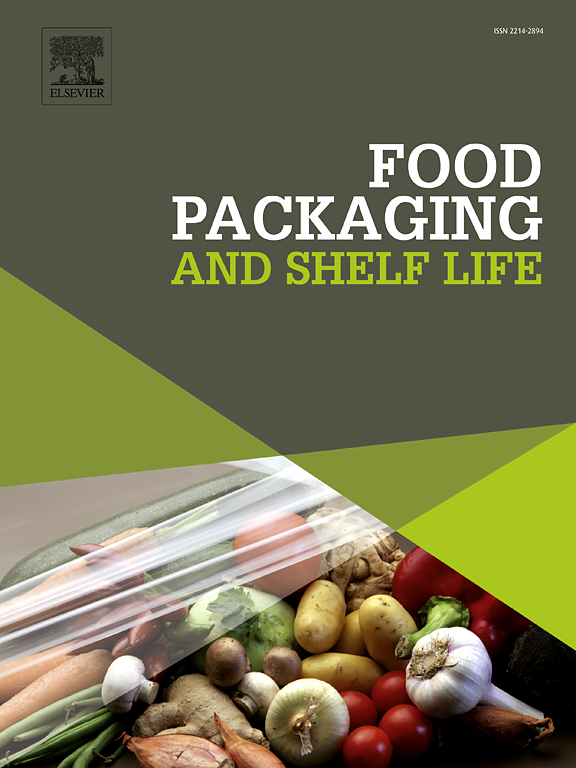Non thermoplastic 3D molding based on coordination crosslinking for on-demand customization carboxymethyl chitosan-based packaging bags
IF 8.5
1区 农林科学
Q1 FOOD SCIENCE & TECHNOLOGY
引用次数: 0
Abstract
The exhaustion of non-renewable resource and the environment pollution of plastic wastes have become a global crisis. Natural polysaccharide is expected to be sustainable and biodegradable alternative to petroleum-based plastics. However, the thermal processing of polysaccharides especially 3D film formation is challenging due to their lack of thermoplasticity. Herein, a novel reverse mold crosslinking film-forming strategy for the preparation of polysaccharide-based 3D film was proposed, where the role of rapid crosslinking molding is similar to that of cooling molding during injecting processing. Through this non-thermal processing, carboxymethyl chitosan/polyvinyl alcohol/Zn (CMCS/PVA/Zn) 3D films were successfully prepared. The CMCS/PVA/Zn exhibits excellent mechanical performance, water resistance, and transparency, meeting the performance requirement in food packaging bags. Moreover, CMCS/PVA/Zn can be customized on-demand, such as shape, size, color, and function, by adjusting the mold or adding functional additive. Notable, multiple carboxyl polysaccharides and metal ions can be used for the preparation of 3D films by this non-thermal processing method, showing great universality. And this method is more energy-efficient than thermal processing and preservers the bioactivity of polysaccharides and additives. Therefore, this innovative approach to polysaccharide processing offers a promising potential for the creation of polysaccharide-based food packaging bags as a sustainable alternative to non-degradable plastic bags.
基于配位交联的非热塑性三维成型按需定制羧甲基壳聚糖基包装袋
不可再生资源的枯竭和塑料垃圾对环境的污染已经成为全球性的危机。天然多糖有望成为可持续、可生物降解的石油基塑料替代品。然而,多糖的热加工,特别是3D薄膜的形成是具有挑战性的,因为它们缺乏热塑性。本文提出了一种用于制备多糖基三维薄膜的新型反模交联成膜策略,其中快速交联成型的作用类似于注射加工过程中的冷却成型。通过非热加工,成功制备了羧甲基壳聚糖/聚乙烯醇/锌(CMCS/PVA/Zn)三维薄膜。CMCS/PVA/Zn具有优异的机械性能、耐水性和透明度,满足食品包装袋的性能要求。此外,CMCS/PVA/Zn可以通过调整模具或添加功能添加剂按需定制,如形状、尺寸、颜色和功能。值得注意的是,通过这种非热加工方法,可以使用多种羧基多糖和金属离子制备三维薄膜,具有很强的通用性。该方法比热加工更节能,并能保持多糖和添加剂的生物活性。因此,这种创新的多糖处理方法为创造以多糖为基础的食品包装袋提供了一个有希望的潜力,作为不可降解塑料袋的可持续替代品。
本文章由计算机程序翻译,如有差异,请以英文原文为准。
求助全文
约1分钟内获得全文
求助全文
来源期刊

Food Packaging and Shelf Life
Agricultural and Biological Sciences-Food Science
CiteScore
14.00
自引率
8.80%
发文量
214
审稿时长
70 days
期刊介绍:
Food packaging is crucial for preserving food integrity throughout the distribution chain. It safeguards against contamination by physical, chemical, and biological agents, ensuring the safety and quality of processed foods. The evolution of novel food packaging, including modified atmosphere and active packaging, has extended shelf life, enhancing convenience for consumers. Shelf life, the duration a perishable item remains suitable for sale, use, or consumption, is intricately linked with food packaging, emphasizing its role in maintaining product quality and safety.
 求助内容:
求助内容: 应助结果提醒方式:
应助结果提醒方式:


